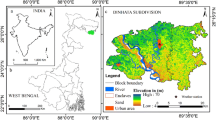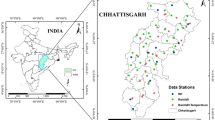Abstract
The climate conditions of Iran vary from extremely arid in south parts to very humid in the northern parts. In the past two decades, severe droughts and population growth as well as inappropriate management of water resources have intensified Iran's water shortage problems. In this study, we used the Polynomial Regression Analysis (PRA) to investigate the trend of climatic parameters, including minimum and maximum air temperature, total monthly rainfall, average monthly relative humidity, sunshine hours, and average monthly wind speed at Fasa Plain, southern Iran with semi-arid climate during 1967–2019. For each parameter, a significant trend in each month was determined by the model contained a linear effect (t), quadratic effect (t2), cubic effect (t3), and so on. Results indicated that the temporal trend of minimum and maximum temperature was significantly increasing (maximum values of 0.358 and 0.316 °C year−1 in March and April, respectively) during 1967–2014. While the trend of rainfall has fluctuated and almost significantly decreased (maximum decrement of − 3.367 mm year−1 in March). Sunshine hours had an increasing trend in recent decades (maximum of 3.220 h year−1 in December), wind speed had a quite negative trend (maximum reduction of − 0.194 m/s year−1 in January), and relative humidity had a more decreasing trend (maximum decline of − 1.284% year−1 in November) in the studied duration. Total changes in the studied meteorological parameters are indicative of more warmth and dryness of the region. Rainfall reduction in March and April is in agreement with warming and drying, during 1967–2014. Then, the validation of the obtained equations was assessed using meteorological data of the study area during 2015–2019. The forecasted results showed the acceptable values of coefficient of determination (R2) between forecasted and actual data. In general, the results of this study indicate a serious warning about warming and climate change in the studied region.

Similar content being viewed by others
Data Availability
The datasets used and/or analyzed during the current study are available from the corresponding author on reasonable request.
References
Agarwal A, Babel MS, Maskey S, Shrestha S, Kawasaki A, Tripathi NK (2015) Analysis of temperature projections in the Koshi River Basin. Nepal Int J Climatol 36(1):266–279
Ahmadi F, Nazeri Tahroudi M, Mirabbasi R, Khalili K, Jhajharia D (2018) Spatiotemporal trend and abrupt change analysis of temperature in Iran. Meteorol Appl 25:314–321
Akiner ME (2021) Long-term rainfall information forecast by utilizing constrained amount of observation through artificial neural network approach. Adv Meteorol 2021:5524611
Ali G, Sajjad M, Kanwal S, Xiao T, Khalid S, Shoaib F, Nayab Gul H (2021) Spatial–temporal characterization of rainfall in Pakistan during the past half-century (1961–2020). Sci Rep 11:6935
Asfaw A, Simane B, Hassen A, Bantider A (2018) Variability and time series trend analysis of rainfall and temperature in northcentral Ethiopia: a case study in Woleka sub-basin. Weather Clim Extremes 19:29–41
Bahrami M, Mahmoudi MR (2020) Rainfall modelling using backward generalized estimating equations: a case study for Fasa Plain. Iran Meteorol Atmos Phys 132:771–779
Bahrami M, Zarei AR, Chakav S (2017) Analysis of drought transitions using log-linear models in Iran. Int J Water 11(3):266–278
Bahrami M, Mahmoudi MR, Zarei AR, Moghimi MM, Amiri MJ (2018) Comparative study among different time series models for monthly rainfall forecasting in shiraz synoptic station. Iran Water Harvest Res 3:29–39
Bahrami M, Bazrkar S, Zarei AR (2019a) Modeling, prediction and trend assessment of drought in Iran using standardized precipitation index. J Water Clim Change 10(1):181–196
Bahrami M, Zarei AR, Moghimi MM, Mahmoudi MR (2019b) Trend analysis of evapotranspiration applying parametric and non-parametric techniques (case study: arid regions of southern Iran). Sustain Water Resour Manag 6:1–14
Bendre MR, Manthalkar RR, Thool VR (2017) Modeling and predicting weather in agroclimatic scarcity zone using iterative approach. Decision. https://doi.org/10.1007/s40622-017-0146-8
Devi S, Purohit RC, Bhakar SR, Lakhawat SS (2017) Spatial and temporal trends of precipitation and temperature for the MPUAT service area, Rajasthan, India. IOSR J Agric Vet Sci 10(7):15–20
Djaman K, Koudahe K, Bodian A, Diop L, Ndiaye PM (2020) Long-Term trend analysis in annual and seasonal precipitation, maximum and minimum temperatures in the Southwest United States. Climate 8(12):142
Elliott WP, Angell JK (1997) Variations of cloudiness, precipitable water and relative humidity over the United States: 1973–1993. Geophys Res Lett 24:41–44
Feizi V, Mollashahi M, Frajzadeh M, Azizi G (2014) Spatial and temporal trend analysis of temperature and precipitation in Iran. ECOPERSIA 2(4):727–742
Gentilucci M, Bisci C, Burt P, Fazzini, M, Vaccaro C (2018) Interpolation of rainfall through polynomial regression in the Marche region (Central Italy). In: The Annual International Conference on Geographic Information Science. Springer, Cham, pp 55–73
Gilliland JM, Keim BD (2018) Surface wind speed: trend and climatology of Brazil from 1980–2014. Int J Climatol 38:1060–1073
Goodale CL, Aber JD, Ollinger SV (1998) Mapping monthly precipitation, temperature, and solar radiation for Ireland with polynomial regression and a digital elevation model. Clim Res 10:35–49
Gul S, Ren J, Xiong N, Khan MA (2021) Design and analysis of statistical probability distribution and non-parametric trend analysis for reference evapotranspiration. PeerJ 9:e11597
Hossain MS, Roy K, Datta DK (2014) Spatial and temporal variability of rainfall over the South–West Coast of Bangladesh. Climate 2:28–46
IPCC (2013) Climate Change: The Physical Science Basis. Contribution of Working Group I to the Fifths Assessment Report of the Intergovern-mental Panel on Climate Change 1535 (Cambridge University Press, Cambridge, United Kingdom and New York, NY, USA, 2013).
Kaboli S, Hekmatzadeh AA, Darabi H, Torabi Haghighi A (2021) Variation in physical characteristics of rainfall in Iran, determined using daily rainfall concentration index and monthly rainfall percentage index. Theor Appl Climatol 144:507–520
Karimi V, Karami E, Keshavarz M (2018) Climate change and agriculture: Impacts and adaptive responses in Iran. J Integr Agric 17(1):1–15
Kouhestani S, Eslamian SS, Abedi-Koupai J, Besalatpour AA (2016) Projection of climate change impacts on precipitation using soft-computing techniques: a case study in Zayandeh-rud Basin, Iran. Global Planet Change 144:158–170
Larbi I, Hountondji FCC, Annor T, Agyare WA, Gathenya JM, Amuzu J (2018) Spatio-temporal trend analysis of rainfall and temperature extremes in the Vea Catchment, Ghana. Climate 6:87. https://doi.org/10.3390/cli6040087
Laurini MP (2019) A spatio-temporal approach to estimate patterns of climate change. Environmetrics 30:e2542. https://doi.org/10.1002/env.2542
Mahmood R, Jia S, Zhu W (2019) Analysis of climate variability, trends, and prediction in the most active parts of the Lake Chad basin, Africa. Sci Rep 9:6317
Mansouri Daneshvar MR, Ebrahimi M, Nejadsoleymani H (2019) An overview of climate change in Iran: facts and statistics. Environ Syst Res 8:1–10. https://doi.org/10.1186/s40068-019-0135-3
Massie DR, Rose MA (1997) Predicting daily maximum temperatures using linear regression and eta geopotential thickness forecasts. Weather Forecast 12(4):799–807
Miri M, Rahimi M (2015) Spatial and temporal trend analysis of temperature parameters in Iran. Geogr J Territory 12(47):65–79
Mondal A, Khare D, Kundu S (2015) Spatial and temporal analysis of rainfall and temperature trend of India. Theor Appl Climatol 122:143–158
Mortuza MR, Selmi S, Khudri MM, Ankur AK, Rahman MM (2014) Evaluation of temporal and spatial trends in relative humidity and dew point temperature in Bangladesh. Arab J Geosci 7:5037–5050
Mudelsee M (2019) Trend analysis of climate time series: a review of methods. Earth Sci Rev 190:310–322
Oe A, Bl L, Ae L, Is S (2017) Spatio-temporal precipitation trend and homogeneity analysis in Komadugu-Yobe Basin, Lake Chad Region. J Climatol Weather Forecast 5(3):1–12
Patle GT, Singh DK, Sarangi A, Rai A, Khanna M, Sahoo RN (2013) Temporal variability of climatic parameters and potential evapotranspiration. Indian J Agric Sci 83(5):518–524
Rahimzadeh F, Pedram M, Kruk MC (2014) An examination of the trends in sunshine hours over Iran. Meteorol Appl 21:309–315
Saboohi R, Soltani S, Khodagholi M (2012) Trend analysis of temperature parameters in Iran. Theor Appl Climatol 109:529–547
Sadeghi SH, Nouri H, Faramarzi M (2017) Assessing the spatial distribution of rainfall and the efect of altitude in Iran (Hamadan Province). Air Soil Water Res 10:1178622116686066
Sanchez-Lorenzo A, Calbó J, Martin-Vide J (2008) Spatial and temporal trends in sunshine duration over Western Europe (1938–2004). J Clim 21:6089–6098
Seager R, Ting M, Li C, Naik N, Cook B, Nakamura J, Liu H (2013) Projections of declining surface-water availability for the southwestern United States. Nat Clim Change 3(5):482–486
Shen M, Chen J, Zhuan M, Chen H, Xu CY, Xiong L (2018) Estimating uncertainty and its temporal variation related to global climate models in quantifying climate change impacts on hydrology. J Hydrol 556:10–24
Shi H, Li T, Wei J, Fu W, Wang G (2016) Spatial and temporal characteristics of precipitation over the Three-River Headwaters region during 1961–2014. J Hydrol Reg Stud 6:52–65
Smith BA, McClendon RW, Hoogenboom G (2006) Improving air temperature prediction with artificial neural networks. Int J Comput Intell 3(3):179–186
Sun Q, Miao C, Duan Q (2015) Extreme climate events and agricultural climate indices in China: CMIP5 model evaluation and projections. Int J Climatol 36(1):43–61
Taxak AK, Murumkar AR, Arya DS (2014) Long term spatial and temporal rainfall trends and homogeneity analysis in Wainganga basin, Central India. Weather Clim Extremes 4:50–61
Touseef M, Chen L, Yang K, Chen Y (2020) Long-term rainfall trends and future projections over Xijiang River Basin, China. Adv Meteorol 2020:6852148
Willett KM, Gillet NP, Jones PD, Thorne PW (2007) Attribution of observed surface humidity changes to human influence. Nature 449:710–713
Wohland J, Omrani N-E, Witthaut D, Keenlyside NS (2019) Inconsistent wind speed trends in current twentieth century reanalyses. J Geophys Res Atmos 124:1931–1940
Yang K, Wu H, Qin J, Lin CG, Tang WJ, Chen YY (2014) Recent climate changes over the Tibetan Plateau and their impacts on energy and water cycle: a review. Glob Planet Change 112:79–91
Yu L, Zhong S, Bian X, Heilman WE (2015) Temporal and spatial variability of wind resources in the United States as derived from the Climate Forecast System Reanalysis. J Clim 28(3):1166–1183
Zarei AR (2018) Evaluation of drought condition in arid and semi- arid regions, using RDI index. Water Resour Manag. https://doi.org/10.1007/s11269-017-1898-9
Zarei AR, Bahrami M (2016) Evaluation of quality and quantity changes of underground water in Fasa plain, Fars (2006–2013). Iran J Irrig Water Eng 6(24):103–113
Zarei AR, Moghimi MM, Mahmoudi MR (2016) Analysis of changes in spatial pattern of drought using RDI index in south of Iran. Water Resour Manag 30:3723–3743. https://doi.org/10.1007/s11269-016-1380-0
Zarei AR, Moghimi MM, Bahrami M (2017) Monitoring and prediction of monthly drought using standardized precipitation index and Markov chain (Case study: southeast of Iran). Geogr Sustain Environ 7(23):39–51
Zarei A, Moghimi MM, Bahrami M (2019) Comparison of Reconnaissance Drought Index (RDI) and Effective Reconnaissance Drought Index (eRDI) to evaluate drought severity. Sustain Water Resour Manag 6:1–20
Acknowledgements
We are grateful to the I.R. of Iran Meteorological Organization (IRIMO) for providing the data.
Funding
No fund.
Author information
Authors and Affiliations
Corresponding author
Ethics declarations
Conflict of interest
The authors declare no conflict of interest.
Additional information
Responsible Editor: Stephanie Fiedler.
Publisher's Note
Springer Nature remains neutral with regard to jurisdictional claims in published maps and institutional affiliations.
Rights and permissions
About this article
Cite this article
Bahrami, M., Mahmoudi, M.R. Long-term temporal trend analysis of climatic parameters using polynomial regression analysis over the Fasa Plain, southern Iran. Meteorol Atmos Phys 134, 42 (2022). https://doi.org/10.1007/s00703-022-00875-9
Received:
Accepted:
Published:
DOI: https://doi.org/10.1007/s00703-022-00875-9




